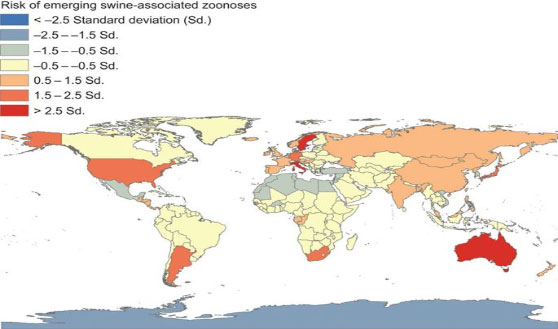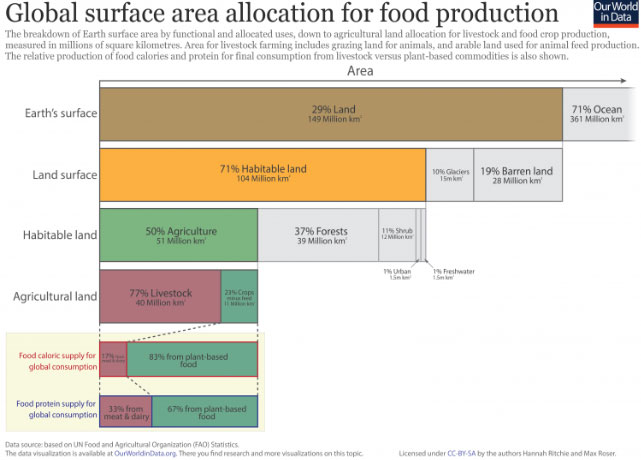The Environmental Impact of Meat Production
Guest post by Honey Gusto, who asks, “Do I need […]
Date Posted:
July 4, 2019

Guest post by Honey Gusto, who asks, “Do I need to give up meat to preserve the Earth?”
Who would have thought that by eating meat, you may actually be negatively impacting the environment. Or to put it bluntly, you are. Well believe it or not, this can actually be the case, and it’s a fascinating concept. It sort of comes as a primal instinct for a lot of us to want to eat meat, just like our ancestor hunted ancient beasts in order to survive.
And so for many of us, it just feels very natural to consume meat. And these animalistic tendencies are spread across the animal kingdom. I mean, if a polar bear saw us walking across the Arctic Tundra (not that many of us plan on doing that), it probably isn’t going to leave you alone, especially if it’s hungry!
Now of course, human beings are at the top of the food chain, and we have come a long way since prehistoric man. The Agricultural Revolution, occurring around 10,000 BC, transitioned our culture from a hunter- gatherer (nomadic lifestyle) approach to farming the land.
So this increased the stability of our food sources, and massively increased our food production, so we could rely on the land rather than our spears. A steady source of food means more energy for the people, which means populations can grow and become stronger.
So, have we actually been harming our landscape for over 10,000 years, and how much longer can we sustain this global farming production? And is veganism, which has greatly increased in popularity in recent years, the answer to many of our problems?
The environmental impacts

While we can give great thanks to the Agricultural Revolution, it greatly increased our population numbers thanks to an abundant food source. And you sort of get this avalanche affect: more people means more food and so on (rinse and repeat).
And so this greatly impacted our environment in a negative way, primarily with the destruction of habitats, and the subsequent killing of the animals that relied on that habitat, which decreases biodiversity.
The destruction of forests gave way to farmland where domesticated animals roam today, such as goats, pigs, sheep and cattle. In the United Kingdom, which was actually the world’s pioneer of more modern forms of agricultural practices in the 18 th century, crops like turnips could be grown during the harsh winter.
Increased crop production led to the increase in livestock (farm animals), as they too had an increased food supply, and their numbers continued to grow (and grow, and grow). Lets take a closer look at how the mass domestication of these animals is negatively impacting Earth.
You can have the effects of overgrazing occurring. Which could perhaps result from too many animals for the land to sustain, or the animals have been grazing on that patch of land for too long, and cannot roam freely (they are domesticated after all) to other locations to allow it to recover.
And so a lot of the essential nutrients can be removed from the soil, but not all grazing is bad. In many instances, grazing can improve the health of soil and grasslands due to the process of nutrient cycling, where the livestock are naturally fertilizing the land by adding nutrients, such as nitrogen, to the soil through biological means.
A major environmental impact is the production of methane (CH 4 ) from cattle, increasing greenhouse gas (GHG) concentrations. Livestock agriculture is responsible for 35-40% of the world’s anthropogenic (human-induced) methane emissions.
Let’s talk about fertilizer
Without it, modern farming would cease to exist, and I bet you, much of the food that you eat has been grown thanks to artificial fertilizer. Now without it we probably wouldn’t be here.
Population growth outstripped the supply of food grown with natural fertilizer (manure), and so we had to look for artificial methods to continue to provide nutrients to the soil for sustainable yields of crops, and to feed livestock. But at what cost? And in many cases, you have to burn fossil fuels to produce fertilizer in the first instance.
Why is meat production particularly bad for the environment? The same mass of beef production produces 57 times as much GHG as potatoes. And according to the United Nations Food and Agricultural Orginisation, the meat industry is responsibly for 14-22% of total global GHG emissions.
And cows get a particularly bad rep thanks to the copious amounts of methane they produce. Now CH 4 is particularly potent – 30 times stronger in fact, to that of carbon dioxide (CO2 ), but to counterbalance that it does have a short residence time in the atmosphere. This is around 10 years, which is 5% of the residence time compared to CO2 .
Mitigation methods
Research has been done to see if amending the cows feed could reduce the amount of methane belched out by cattle. If you can grind the feed into finer amounts, this could aid in the cows digestion, taking less time and energy to digest, which can reduce the amount of CH 4 emitted. This could improve cows metabolic activity, reducing fermentation and decreasing methane emissions.
Improving fertilizer blends can also make a difference. The key is to produce far less nitrogen and phosphorous, as artificial fertilisers usually produce excess, which is bad for the environment. Blends that are also less susceptible to runoff are continually being researched.
Methane capturing systems perhaps? Well, some facilities are able to capture methane emitted from manure. And scientists have even looked at enhancing biological decomposition rates of manure in the soil, so that it doesn’t escape into the atmosphere.
Anybody fancy lab-grown meat?

nations are 1st world countries.[4]
There are a couple of notable benefits of from laboratory grown meats. Firstly, the culture process could essentially be aseptic, which means free from bacteria. If you don’t have bacteria, then you don’t have contamination, which means you don’t have food-bourne illnesses.
Another positive aspect for human health is the reduction of farm animals could lead to a reduction in disease crossover from animals to humans such as bird flue and tuberculosis.
Now most of these transmissions occur in developing countries and middle-income countries, but given the fact that a lot of infectious diseases are zoonotic (transmitted from animals to humans), the reduction of livestock could be seen as a major global human health improvement.
In fact, research has found that the 13 most common zoonotic diseases are responsible for 2.2 million human deaths each year, with the vast majority of disease transmission coming from livestock.
The future of the meat industry
The world’s population is currently at 7.7 billion for 2019. It is projected to increase to 9.8 billion by 2050, and with that, many believe that this human population growth will drive up meat consumption. Further increasing carbon emissions and hindering biodiversity.
In 2013, the first ever lab-grown beef burger was served up in London. This was a major breakthrough, and over time as this technology develops, we may see a shift from field-produced meat to lab-grown meat in large- scale factories.
Now this may not scream out squeaky clean environmental abidance, but think of the benefits for a second. You would have far less fertilizer usage and so lessening the amounts of nitrogen and phosphorous being added to the land. Also, far less land would be used for meat cultivation and the associated animal feed.
Instead, the land could be used for biofuel feedstock, meaning you would use the land to grow crops to serve our biofuel needs, which emits far les CO 2 than conventional means, and if biofuel crops are properly managed, you potentially have a fuel source that will never run out.
Therefore, we may find that in 10-20 years from now, the meat on our dinner plates will come from labs, synthetically made, and mass-produced once it becomes economically competitive.
Is veganism the answer?
As an individual, you can make a difference. If you want to join the movement of people who are giving up meat and substituting dairy products for more environmentally friendly foods, you can make a notable change.
At the end of the day, if the demand for cattle and dairy decreases, it isn’t economically viable to continue with the high supply. Now that’s being environmentally conscious because at the end of the day, our diets are a choice. Eating a plant-based diet could be the way forward, for many of us.

There is no hiding for the meat and agriculture industries. They are a major emitter of GHG and so playing a big role in climate change. Agriculture consumes 10% of our global freshwater and livestock takes up nearly 80% or our arable land.
As you can see, a whopping 50% of our habitable land is used by agriculture, the majority of which is livestock. And with population increasing and food demand on the rise, will we see more agricultural land in the future? One thing is for certain; we need to become better at managing the food supply chain.
Big investors are now looking at major corporations like McDonalds to go to their suppliers and negotiate a more environmentally friendly process. McDonald’s have stated they plan on taking an equivalent of 32 million cars off the road by 2030, so perhaps there is light at the end of the tunnel.
References
- Bryner, J. (2012). 13 Animal-to-Human Diseases Kill 2.2 Million People Each Year. [online] Live Science. Available at: https://www.livescience.com/21426-global-zoonoses-diseases-hotspots.html [Accessed 31 Jan. 2019].
- Fiala, N. (2009). How Meat Contributes to Global Warming. February 2009 Scientific American Magazine, pp.1-3.
- Gillaspy, R. (n.d.). The Agricultural Revolution: Impacts on the Environment. [online] Study.com. Available at: https://study.com/academy/lesson/agricultural-and-industrial-revolutions-impacts-on-the-environment.html [Accessed 29 Jan. 2019].
- Khan, S., Atanasova, K., Krueger, W., Ramirez, A. and Gray, G. (2013). Global distribution of swine-associated emerging zoonoses, 1970 to 2012.. [image] Available at: https://www.nature.com/articles/emi201387 [Accessed 31 Jan. 2019].
- Koneswaran, G. and Nierenberg, D. (2008). Global Farm Animal Production and Global Warming: Impacting and Mitigating Climate Change. Environmental Health Perspective, 116(5), pp.578–582.
- Leonard, J. (2019). Brexit: MP’s back May’s bid to change deal. Global News Podcast.
- Mattick, Carolyn, and Brad Allenby. “The Future of Meat.” Issues in Science and Technology 30, no. 1 (Fall 2013).
- Ritchie, H. (2017). The worlds current land use and agricultural standing. [image] Available at: https://ourworldindata.org/agricultural-land-by-global-diets [Accessed 31 Jan. 2019].
- Wikipedia (2019). Environmental impact of meat production. In: Wikipedia. Wikipedia Foundation Inc.
- Zeller, U., Starik, N. and Gottert, T. (2017). the pie chart represents Earth’s biomass for livestock, humans and wild animals. Livestock is the clear winner, with numbers still increasing.. [image] Available at: https://www.researchgate.net/figure/Estimations-of-the-total-global-biomass-organically-bound-carbon-regarding-humans-wild_fig3_314653548 [Accessed 30 Jan. 2019].